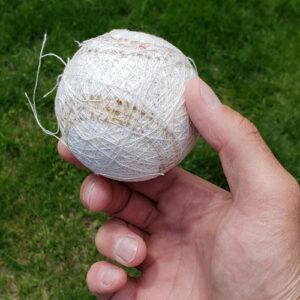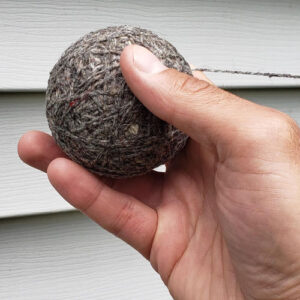Ever wonder how long the wool is inside of a baseball? I unraveled one so you don’t have to. All thread and wool layers combined measure 1,107 feet! Let us break down a baseball’s layers for you, before you throw your next one.

The Baseball – The Pearl of Wisdom
An official baseball weighs between 5 and 5.25 ounces and measures between 9 and 9.25 inches in circumference. They are all slightly different. Each has three basic parts:
- Cowhide covering with red stitching on the outside.
- The wool and poly cotton windings in the middle.
- The round cushioned cork pill at its core.
But each layer is more complex. According to Steve Rushin in his book, The 34-Ton Bat, “a cross section of a baseball looks like a cross section of planet Earth. The tired assertion that baseball is a microcosm of America obscures the fact that baseball really is a microcosm, a little world.” And it is.

Here is something else you probably did not know about a baseball: The inner cork and rubber pill are not perfectly centered inside the ball. This is what causes the ball to wobble in the air when hit. This makes every ball unique, like a small white, round, leathery snowflake. Catch one if you can!

Sewing Hide – The Outside Story of a Baseball
Cutting open a baseball is harder than you’d think. And I didn’t want to ruin a perfectly good ball, so I found one my dog played with a little. The baseball’s outer cover is made of Number One Grade, alum-tanned full-grained cowhide, primarily from Midwest Holstein cattle. And this explains why my dog loves baseballs.
The cowhide covering is cut into two figure-8 patterns, each covering half the wound ball. Before they are stitched to the wound ball, the cowhide coverings are dampened to increase their pliability. The insides of the coverings receive a coating of adhesive to stick to the wound ball.
The coverings are stapled to the wound ball, then they are hand-sewn together using 88 inches of waxed red thread. There are 108 stitches in the sewing process, with the first and last completely hidden – so if you count, don’t claim B.S. if you only count 106 stitches!
FYI: It takes an average of 13 to 14 minutes to hand-sew a baseball. Consider that next time you hit one into the woods for no reason.
After the covers have been stitched together, the staples are removed and the ball is inspected. The ball is then placed in a rolling machine for 15 seconds to level any raised stitches. The baseballs are then measured, weighed and graded for appearance. Acceptable baseballs are stamped with the manufacturer’s trademark and league designation.
A finished baseball weighs between 5 and 5.25 ounces and measures between 9 and 9.25 inches in circumference.
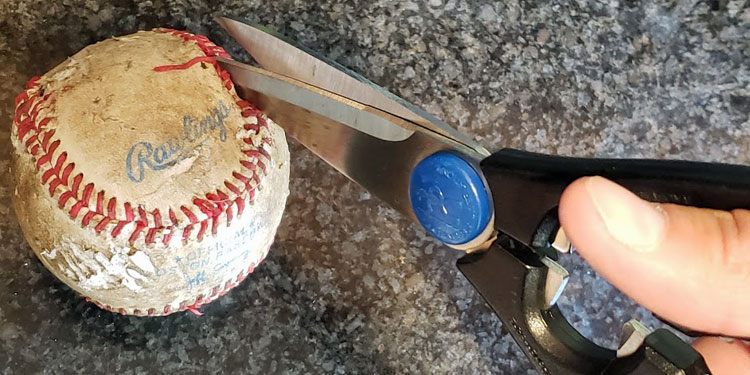
Wool & Yarn & Cotton – The Winding Fabric of Our Lives, and Baseball
Wool is used as as the primary material for the baseball’s windings because it compresses easily when pressure is applied, then rapidly return to its original shape. This makes it possible for the baseball to retain its perfect roundness despite being hit repeatedly.
There are four distinct layers of wool and poly cotton windings that surround the cushioned cork pill to create a baseball.
- White Poly Cotton Finishing Yarn – This winding provides strength and reduces the risk of tears when the ball’s cowhide cover is applied. This outer layer is tough to unravel, as you need to find the end, then remove it slowly so it doesn’t break. It is attached lightly to the glue from the cowhide, and is like untangling a spider web. It is thread-like, and there are 450 feet of it. This layer holds the other layers of yarn in place. After unraveling this thread, the ball is down to 8-3/4 inches in circumference.

- Gray Wool Yarn (3 ply) – This layer is 159 feet, comes apart seemingly easily after suffering through the outer layer of gluey thread. Once this layer of wool is unraveled, the ball is reduced to 8-3/16 inches in circumference.

- White Wool Yarn (3 ply) – This layer is 135 feet of three-ply white woolen yarn. When done unraveling, 7-3/4 in circumference of baseball remain.
- Gray Wool Yarn (4 ply) – Oh joy, more yarn! This time, the 363 feet inner-most winding is made of four-ply gray woolen yarn, which is the thickest layer by far. When this is unraveled, only the pink pill remains.
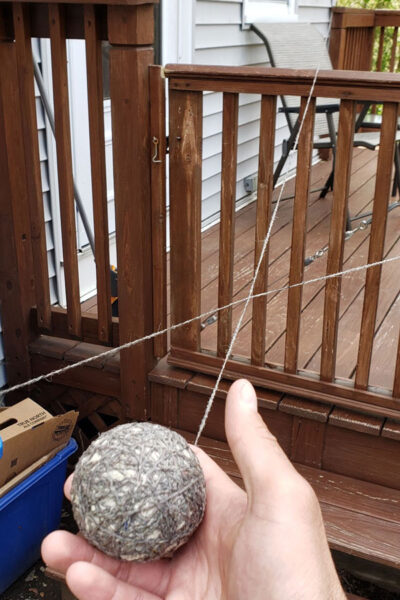
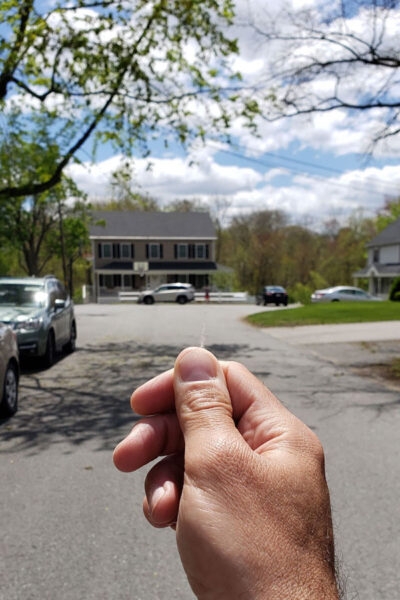
The Pill – A Rubber for a Different Kind of Control
The pill inside the yarn layers is made from a cork and rubber composite material. It measures 4-1/8 in circumference and 13/16 of an inch in diameter – like a rubber bouncy ball, but less bouncy. This sphere is encased in an outer pinkish layer, then a black inner layer inside that one. The inner layer is made up of two hemispheric shells of black rubber that are joined by red rubber washers.
The pill is not perfectly centered inside the ball. This is what causes the ball to wobble in the air when hit. As an outfielder, I always thought this was an optical illusion when you were chasing down a fly ball. Nope. The ball is wobbling.
The belief is that Rawlings has gotten better at centering the pill in recent years. As a result, baseballs today sail through the air straighter, smoother, and farther than they have historically. But if you pay for cheaper baseballs to save money, it may not travel as straight. Who knew!?
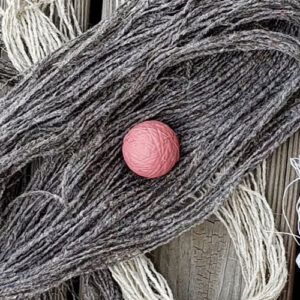
Here’s what the big guy himself, MLB commish, Rob Monfred had to say about the pill.
They [Rawlings] haven’t changed their process in any meaningful way. They haven’t changed their materials. There’s two points that I would make, even in the report last year: The scientists identified the pill in the baseball — not what it was actually composed of — but the centering of the pill in the baseball as something that could be a drag issue. To the extent that the pill is not perfectly centered, the ball wobbles when it’s hit, creates more drag. We think one of the things that may be happening is they’re getting better at centering the pill. It creates less drag.
Rob Manfred, MLB Commissioner
Making of a Baseball Remains a Team Sport
While I fully untangled this baseball and attempted to do all the measuring myself, this is a near impossibility. The thread glued to the baseball ripped repeatedly (maybe because my dog had previously chewed the ball, but nevermind that). Plus, the wind blew the scraps of thread all over the place (no matter how carefully I tried to stuff them in my pocket).
Shockingly, there were fewer details online about the baseball making process than I would have expected. I wanted to verify my own findings! Still, there were two solid resources that helped me get my facts straight once my own baseball unraveling was complete:
Brett Rudy is a trailblazer in the world of baseball. As the founder of Baseball Is My Life and co-founder of Charity Hop Sports Marketing, he’s dedicated to elevating the sport and supporting the athletes who play it. With a passion for making a difference, Brett has created successful philanthropic initiatives like Charity Wines and 100 Innings of Baseball for ALS. He’s also the mastermind behind the Corked Bat Collection, Cooperstown Classic at the Baseball Hall of Fame, and Winterball for Toys for Tots. When he’s not working to improve the game, Brett can be found playing outfield in the Boston Metro Baseball League, living and breathing the sport he loves.
